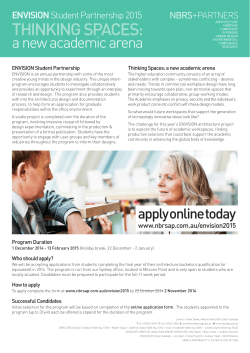
ABF Clinical Engagement Susan Dunn & Hirani Jayasinha ABF Taskforce May 2013
ABF Clinical Engagement Susan Dunn & Hirani Jayasinha ABF Taskforce May 2013 Why is Clinical Engagement Important? Understand their operational contribution in ABF Currently clinical practice is reflected in the costing process which then informs the funding model Collaboration in addressing unwarranted clinical variation Identification of appropriate clinical practice Understand the cost profile of the appropriate clinical cost Aim is for funding to reflect the cost of appropriate care Ensure correct funding messages are being heard Drive improved patient outcomes Key Strategic Approaches Communication Education & Tools Relationships Data Relationships Relationships Promote a culture of partnership between clinicians, policy makers and administrators with key agencies – Clinical Excellence Commission (CEC) – Agency for Clinical Innovation (ACI) – Bureau of Health Information – Health Education and Training Institute – Local Health Districts (LHDs)/Specialty Health Networks (SHNs) Agency for Clinical Innovation Relationships ABF Taskforce have engaged with ACI , building relationships with clinical Networks to discuss funding models and build costing models based on best practice. ACI promotes innovation, by engaging clinicians then designing and implementing new models of care Clinical Networks – design and support implementation of models of care which spread best practice across the NSW health system – provide expert advice to the NSW Government and Ministry of Health to improve patient care and address inequities in access Signs of success, – positive feedback and the Tupperware effect Case Study – Renal Dialysis Network IHPA required Home Delivered Services to be collected at a patient level for each patient administrated service Unwilling to put this burden of data collection onto clinical staff Raised issue with key stakeholders in Renal Dialysis Network Developed a solution framework Met with Renal Network, Renal Dialysis Network and individual stakeholders to outline issue and to discuss proposed solution Gained support and commitment to work with the solution Design phase has now commenced on a reporting solution based on Prescription, census and leave option LHD/SHN Relationships Relationships LHD/SHN Clinicians , ABF Coordinators, Non admitted staff and SNAP staff Majority of NSW ABF Workstream Working Groups have clinical co –chairs and clinical membership Providing input into policy direction and policy support Improves ability to feedback to IHPA Identify clinical champions Provide regular information Support and focused projects Hunter New England LHD Case Study Working with clinical groups and junior medical staff on improving clinical documentation Improved understanding of use of resources and variation in clinical management of patients, including length of stay and use of diagnostics Activity/cost data included in Grand Rounds to emphasise issues with respect to gaining a more holistic view of patient care and discuss better ways of managing frequent repeating patients Comment from a senior clinician that based on the aggregate cost it would have been better for the patient and system to pay for a full time carer Illawarra Shoalhaven LHD Case Study Orthopaedics - identification of prostheses and comparisons amongst sites has led to further work in standardising implants used and renegotiating the price with the contractors Costing has been used to identify the costs of readmissions due to surgical infections Provision of costing data to Grand Rounds to identify costs of long stay patients and discuss impact if treatment was varied or supplied in a different setting Use of activity and costing data in working with sites and clinicians on clinical pathways for selected DRGs Reviewing benchmarking reports to compare with peers and exemplar hospitals Education - Health Education and Training Institute Relationships Supports and promotes coordinated education and training (clinical and non-clinical) across NSW Health System Assures workforce competency and the capacity to deliver safe, effective and efficient health care to the people of NSW Offers an online learning-course on ABF developed in collaboration with ABF Taskforce Education & Tools Education & Tools Education - Other Documentation – Factsheets, Practical Guide, Casemix Handbook, SNAP Handbook Tools – NWAU calculators: Acute and ED Data Data Timely, Accurate, Transparent, Comparative, focused ABM Business Information System 2011/12, DRG E65A CHRNIC OBSTRCT AIRWAY DIS +CCC 0 2000 4000 Allied Other 6000 Blood Path 8000 Imag Pharm Mean Costs($) 10000 Med Pros 12000 Nurs 14000 16000 Data – ABM BIS Key to pulling it together: Communication Site visits Presentations to clinical groups Linkage with local ABF Coordinators Bulletins and factsheets Handbooks, guidelines Data timeliness and robustness Transparency Open and honest communication Communication Future Initiatives Establishing NSW Clinical Casemix Advisory Committee – to provide stronger links between NSW Health and LHDs/SHNs Developing further education materials (publications and online modules) targeted to clinicians Providing focused analysis of activity, costing and benchmarking data for ACI Clinical Networks – Incompatible ABO renal transplant – Complex foot clinic – ED Benchmarking “What’s in it for me?” Understanding that best clinical practice and ABF are not mutually exclusive Quality patient care costs less Transparency Timely, accurate, comparative data Trust Communication & collaboration
© Copyright 2025















